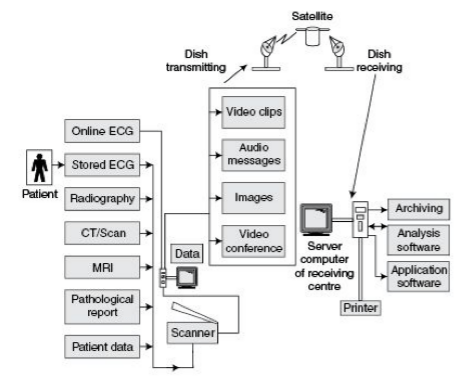Telemedicine is the use of telecommunication and computer technologies to deliver health care from one location to another. Telemedicine employs modern information technology to deliver timely health services to those who need it by electronic transmission of the necessary expertise and information among geographically dispersed parties. Physicians, laboratories and patients can be the distant parties.
Telecommunication enables all parties to interact as if they are at one place, resulting in improved patient care and management, cost-effectiveness and better utilization of expertise.

Telemedicine system includes:
- Hardware
- Software
- Medical equipment
- Communication link
Telemedicine System
The block diagram of a typical telemedicine system is shown below:

Concepts of a Telemedicine System
Store and Forward Concept – This involves the compilation and storing of information relating to audio, video images and clips, ECG, etc. this stored information which is in digital form is sent to an expert for review, interpretation and advice. The expert’s opinion can be transmitted back without any compulsion on the consultant’s time.
Real time telemedicine –Involves real-time exchange of information between the two centres simultaneously and communicating interactively. It may include video conferencing, interviewing and examining the patients, transmission of various anatomic sites, reviewing of images and auscultation of the heart & lung sounds.
Find out more about: Fingertip Pulse Oximeter Blood Oxygen Saturation Monitor
Telemedicine System Technology
Transmission of medical images
Transmission and acquisition of medical images like X-rays, CT, MRI, histopathology slides, etc. is the most important aspect of telemedicine. The images are required to be converted in a digital form before they are transmitted over a telemedicine system. The types of diagnostic images used in telemedicine include:
- Images stored on traditional film or print media e.g. X-ray film and converted into digital format by direct imaging or scanning in a raster sequence under lighting conditions. Charge coupled devices (CCD) and laser based scanners are commercially available for digitizing the film recorded x-ray images.
- Computer-generated images like ultrasound, CT that are available in standard video form (ATSC). Computer format (SVGA), or computer file from (TIF). In modern digital radiography systems, the X-ray image is stored in computer in the digital format. Being a filmless system, it doesn’t require any further digitization.
Once the images are transmitted, there is a need for the local storage of image data. The number of images that may be stored depends upon the size of the storage facility e.g. (Hard disk) and the amount of data compression applied to the images before the storage.
Find out more about: Fingertip Pulse Oximeter Blood Oxygen Saturation Monitor
Transmission of video images
Telemedicine applications in most cases require video and individual still-frame images for interactive visual communication and medical diagnosis. Images are obtained from direct visualization by a video camera and a lens system for direct observation. The most commonly used digital camera is based on the use of charge coupled device (CCD).
Transmission of Digital Audio
Audio channels are usually provided for diagnostic instruments such as electronic stethoscope or Doppler ultrasound. To reproduce heart and lung sounds accurately, an electronic stethoscope must have a uniform frequency response from 20 Hz to 2 kHz, while Doppler ultrasound requires a uniform frequency response from 100 Hz to 10 kHz. The audio used for conversation and medical diagnosis in telemedicine must be digitized and compressed before it can be combined with digital video and other information.
Video conferencing
Video conferencing allows real-time transmission of audio, video and graphics medical information. Telemedicine video conferencing uses telecommunication technology.
Applications of Telemedicine
Although Telemedicine can be applied to all medical specialities, it is mainly used in:
- Radiology
- Pathology
- Cardiology
- Medical education
Telecardiology – Telecardiology relates to the transmission of ECG, echocardiography, etc.
Telepathology – To obtain an expert opinion on the microscopic images of pathology slides and biopsy slides from specialists.
Teleradiology –Radiology images such as X-rays, MRI and CT images can be transferred from one location to another for expert interpretation and consultation. This process involves image acquisition and digitization.
Tele-education –Delivery of medical educational programmes to the physicians and the paramedics who are located in remote areas or smaller towns and professionally isolated from major medical centres.
Teleconsultation –Specialist doctors can be consulted by a patient directly or by the local medical stuff through telemedicine technology.
Related: Biotelemetry Applications in Medicine

Leave a Reply
You must be logged in to post a comment.